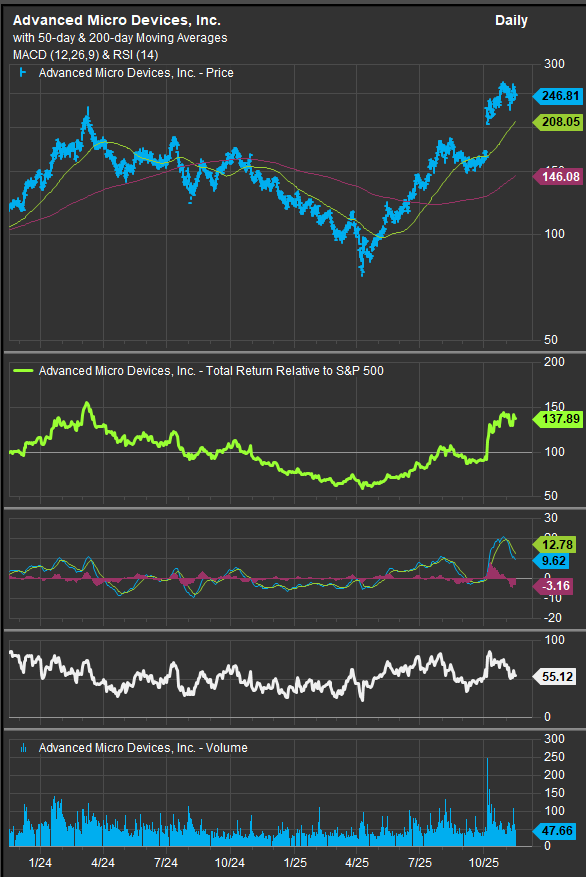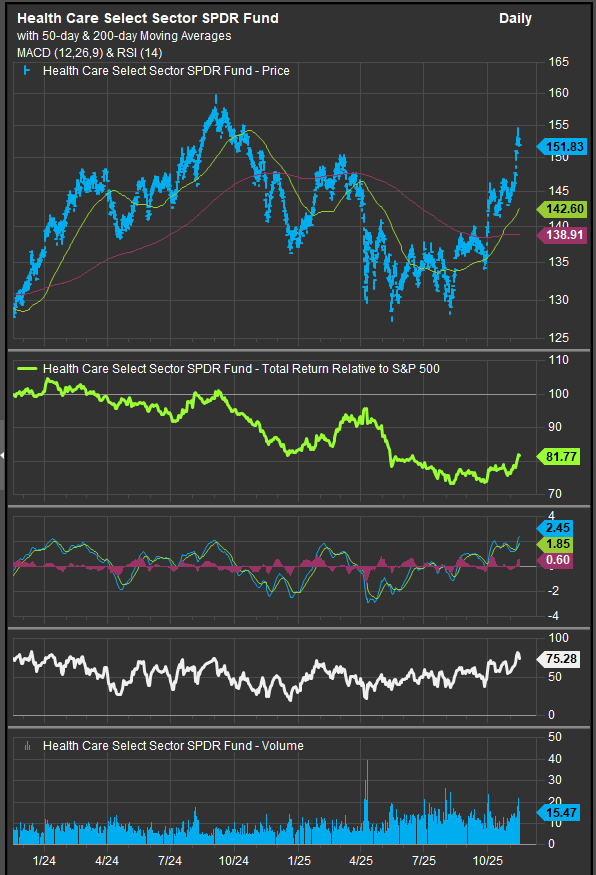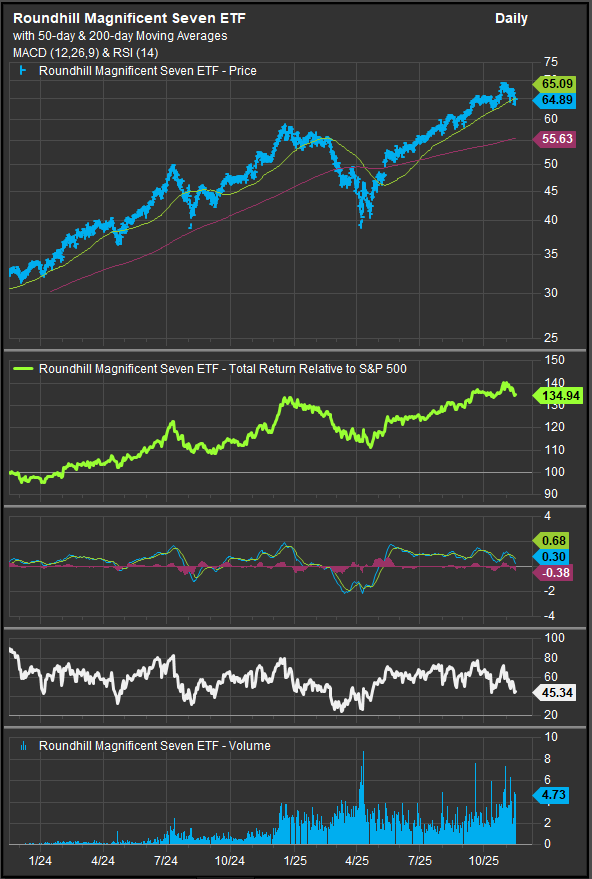November 16, 2025
After one of the sharpest momentum unwinds of the year to start November, investors head into next week facing an unusually wide set of possible outcomes. AI leaders, retail favorites, most-shorted names, crypto, and quantum-computing plays were among the biggest laggards again, reinforcing the sense that the momentum trade may be in the middle—not the end—of a re-rating. At the same time, hawkish Federal Reserve commentary, a lingering data vacuum from the record shutdown, fragile consumer signals, and renewed scrutiny on leveraged AI business models have pulled the market into a defensive crouch.
Yet this is not an environment of capitulation. Earnings remain strong, sector rotation is still functioning, and several real-economy indicators suggest resilience beneath the surface. With this backdrop, investors are weighing three broad positioning paths: leaning into low-volatility/defensive factors, rotating toward commodities and resource equities, or staying long the AI/momentum trade despite its recent stress. Each path offers advantages—but also real risks.
The Bearish View: Momentum Exhaustion and Macro Friction
The bear case leading into next week is grounded in both positioning pressure and macro uncertainty. Goldman Sachs reported another 6.4% decline in its High Beta Momentum Pair—the worst since January—while Morgan Stanley QDS noted its long-leg momentum exposure is now down 19% since mid-October, consistent with prior unwind cycles. At the same time, concerns around AI leverage have intensified: SoftBank’s full exit from Nvidia, CoreWeave’s guidance cut, expanded credit spreads in the tech complex, and Oracle’s recent heavy selloff all point toward investor discomfort with capital-intensive AI buildouts.
On the macro side, recent hawkish Fedspeak has pushed December rate-cut odds down toward 40–50%, tightening financial conditions just as the U.S. economy is dealing with a shutdown-induced blind spot. Labor-market softness—ADP’s late-month weakness, Verizon’s 15,000 job cuts, and surveys showing the weakest expected job market for college grads in five years—adds to the unease. Consumer fragility is becoming harder to ignore: grocers report accelerating private-label adoption, retailers are preparing to sacrifice margins to protect volume, and even many six-figure households report feeling stretched.
This combination—crowded positioning, valuations under review, and macro readings that are inconclusive at best—creates legitimate near-term headwinds for AI, cyclicals, and high-beta momentum.
The Bullish View: Rotation, Not Collapse, and Supportive Earnings Trends
Despite the pressure, the bull case remains intact in several important ways. The recent price action looks more like rotation than broad de-risking. Healthcare, for example, has emerged as a quiet leader: earnings revision trends are stabilizing, valuations are attractive, and both insiders and hedge funds have been buyers. The Bloomberg US Aggregate Bond Index is on track for its best year since 2020, easing some of the rate burden on equities.
Crucially, S&P 500 earnings remain strong. With more than 90% of companies reporting, blended EPS is up more than 13%, revenues are up over 8%, and the beat rate is well above the five-year average. Importantly, companies issuing positive guidance outnumber negative ones by 2-to-1, and Jefferies highlights the strongest upward EPS revisions since 2021.
Consumer data, while mixed, is showing enough resilience to complicate the bear case. American Express sees Q4 billings tracking similarly to Q3’s strength, and Bank of America card data shows October spend up 2.4% y/y. In China, luxury demand is stabilizing after months of weakness, offering relief to a key cyclical segment.
The AI bubble narrative is also getting louder pushback. Goldman Sachs argues today’s AI market resembles 1997–1998 more than 1999–2000, pointing out that system-wide leverage is far lower than in the dot-com era. Powerful micro data reinforce this: AMD forecast “insatiable” AI compute demand with a $1T silicon TAM by 2030; Cisco reported record AI infrastructure orders; Alphabet is preparing Gemini 3.0 and investing $40B in new data centers; and Berkshire just added a $4.3B Alphabet stake. These are not signals of late-cycle exhaustion.

Option 1: Lean Into Low Volatility
Increasing exposure to low-volatility and defensive sectors—particularly Healthcare—offers the cleanest hedge against the current macro uncertainty. Health Care is benefiting from steady demand, stabilizing revisions, and attractive valuations relative to Tech. Staples and Utilities provide ballast, though they carry valuation and rate-sensitivity risk.
This approach appeals if the priority is drawdown protection while the labor market, consumer picture, and Fed path remain unclear. The risk is opportunity cost: if AI stabilizes, the shutdown data gap closes, and Fed rhetoric softens even modestly, defensives will lag quickly.

Option 2: Add Commodities and Resource Equities
Energy and Materials remain compelling for investors seeking valuation support, balance-sheet strength, and exposure to global reflation.
WTI’s stability—even after Russia’s Novorossiysk port attack and ongoing sanction disruptions—reflects a market with real supply risk but skeptical demand expectations. If any demand upside emerges, Energy equities can rerate sharply from low starting valuations.
Materials—especially metals producers—also look increasingly constructive as Chinese investors rotate away from expensive AI chipmakers toward utilities and metals, signaling a shift in domestic sentiment.
The downside: commodities remain macro-beta heavy and volatile, and the IEA–OPEC divergence on 2026 demand forecasts highlights how uncertain the forward curve remains.
Option 3: Stay Long AI and Momentum—Selectively
Remaining long AI/momentum requires acknowledging the near-term risks of leverage, regulatory pressure, and de-crowding—but also recognizing the long-term power of the earnings and adoption cycle. The momentum unwind is painful but not unusual, and it has yet to break the earnings or demand narrative for the highest-quality AI names.
Staying long means leaning into businesses with:
- strong cash flow (MSFT, GOOGL, AMZN, AAPL),
- clear data-center scaling paths,
- recurring model-driven demand, and
- minimal dependence on external financing.
It also means avoiding speculative AI equities that rely on debt-funded capacity buildouts or lack visibility into monetization. The AI story is intact—but the market is forcing investors to distinguish between structural winners and beta proxies.

Conclusion: A Barbell Approach Remains the Best Risk-Adjusted Path
Next week’s setup does not argue for abandoning AI, rotating entirely into commodities, nor hiding exclusively in low-vol defensives. Instead, the environment favors balance-sheet strength, earnings visibility, and diversification across factor exposures.
The highest-probability portfolio for this stage of the cycle remains a barbell:
- Defensives and low-vol sectors (especially Healthcare) to manage drawdown risk while macro uncertainty and the data vacuum persist.
- Commodities and resource equities to take advantage of valuation support and optionality around growth, inflation, and geopolitics.
- Selective high-quality AI exposure, focusing on cash-generative mega-cap platforms rather than leveraged capacity-builders.
Momentum has cracked, but the cycle has not. Until the Fed’s December path comes into focus and the economic data normalizes, investors are likely to be rewarded for quality over beta, diversification over concentration, and prudence over aggression—while still keeping one foot in the secular growth themes driving the next decade of earnings power.
At ETF Sector, our models are showing a momentum “sell” into month end, but an oversold condition would prompt us to consider accumulating momentum themes. The next two weeks will be pivotal from a technical perspective. We saw downside momentum selling in Tech names dry up on Friday, and we don’t think recession is any kind of foregone conclusion. The current bout of selling is a healthy part of the equity market’s discounting function, and we remain constructive on the Growth trade over the longer-term. That said, the break higher in commodities prices has our attention as well. Potential inflation drivers would be a bogey for the Tech/Growth trade and a headache for the Fed.
Data sourced from:
Reuters
Bloomberg
Financial Times (FT)
CNBC
Business Insider
Axios
Politico
The Hill
DigiTimes
ABC News
AP (Associated Press)
NBC News
Additional charts and data sourced from FactSet Research Systems inc.
